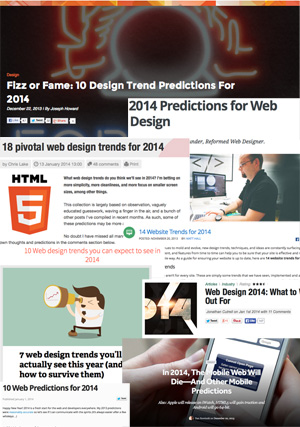26 Jan Web Design Trends for 2014
It’s the first month of the year, and all our favorite web gurus and resources have been issuing their predictions for 2014. The opinions range, of course. An expert in responsive design, for example, is going to identify different innovative trends than a developer working on creating a new content management system. While reading through the slew of advice, certain predictions kept cropping up. Below are the most frequently mentioned trends taken from an informal survey of webdesign blogs:

Flat design:
Microsoft’s Windows 8 and Apple’s iOS7 dropped skeumorphism, and the design world celebrated. Almost every blog predicts that flat design will continue to be popular in web design, permitting the focus to be on the website text, with fewer and less distracting images. Web designer Joseph Howard of Pencil Scoop speculates that flat design will evolve into layered design as a way of creating more textured, distinctive layouts. Envato’s CEO Collis Ta’eed sees an upswing on trends such as long shadows, and also predicts layering and gradients applied subtly so as not to detract from the flat sensibility.
Video and motion:
Almost every web design trend article predicted an upsurge in the use of video. Chris Lake, Director of Content of Econsultancy, and Matt Hall of Web Ascender see video backgrounds becoming more prevalent as newer browsers and faster page load speed enables their use. (For a beautiful example, Lake points to The Guardian’s online article, “The Firestorm.”) Amber Leigh Turner on The Next Web predicts video will be utilized more often as a hero graphic in lieu of a banner image or slide show, while Howard sees room for video use to grow in blogging, Google hangouts, and news services. While parallax effects (slideshows and scrolling) have been around for a while, both Howard and Webascender predict their usage will continue to grow and become more mainstream in the websites of more prominent, established companies. Front-end designer Jonathan Cutrell on Webdesign Tuts+ sees a rise in animated and responsive icons, creating a new trend in user experience.
Design for mobile devices / increased scrolling:
It’s not a surprise that web design gurus see design for mobile devices continuing to increase in importance. Craig Butler, Director of OptimalWorks Ltd, predicts that from 2013 to 21014, mobile access will increase from one in five web visits to one in four. Both Benjie Moss of Wedesigner Depot and Dan Rowinski, Mobile Editor at ReadWrite, predict the long-anticipated death of the mobile web, the development of a secondary website designed to work exclusively on mobile devices. Moss doesn’t see this as an entirely good thing, pointing out that some businesses (such as restaurants) may prefer to direct content differently for desktop versus mobile viewers. The increased viewing on mobile devices has re-familiarized website visitors with scrolling, which is facilitated by swiping. As a result, Hall, Turner, and Lake all see longer scrolling sites becoming acceptable again, and outdated terminology such as “above the fold” being finally dropped.
SVG (Scalable Vector Graphics):
Another prevalent prediction is the increased use of SVG, in part driven by the popularity of icons. As Moss points out, SVG icons have a huge advantage, in that they are more efficient than icon font files, are responsive, and fit with the popular flat design sensibility. Animated SVGs, already popular as icons, will become more prevalent; Howard cites a number of tools and sources which ease their implementation. (Howard also predicts the death of the raster icon, in part because of the availability of SVG and icon fonts.) Cutrell highlights a beautiful example of SVG created by fixate.it, and sees the development of accessible tools for the creation of infovis (graphical representations of data).
Other web design trends include the increased use of CSS to generate imagery, the prevalence of larger images, both as hero images (replacing slide shows) and as backgrounds, the integration of more interesting typography, and the use of fixed headers. Check out our list of references below to read the predictions in full:
Fizz or Fame: 10 Design Trend Predictions For 2014, Joseph Howard, Pencil Scoop
2014 Predictions for Web Design, Collis Ta’eed, Envato
18 pivotal web design trends for 2014, Chris Lake, Econsultancy
14 Website Trends for 2014, Matt Hall, Web Ascender
10 Web design trends you can expect to see in 2014, Amber Leigh Turner, The Next Web
Web Design 2014: What to Watch Out For, Jonathon Cutrell, Webdesign Tuts+
10 Web Predictions for 2014, Craig Bulter, sitepoint
7 web design trends you’ll actually see this year (and how to survive them), Benjie Moss, Webdesigner Depot
In 2014, The Mobile Web Will Die—And Other Mobile Predictions, Dan Rowinski, ReadWrite
